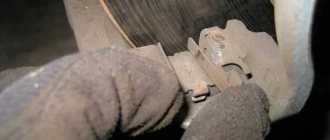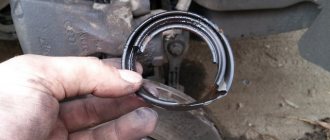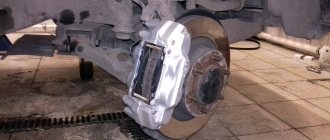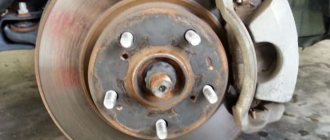| № | Name | Rating | Nomination |
| 1 | ATE 13046057652 | 4.41 | The most reliable braking |
| 2 | Bosch 0986494154 | 4.05 | |
| 3 | TRW GDB3424 | 3.69 | The most popular among RAV 4 owners |
| 4 | BLUE PRINT ADT342171 | 3.55 | The best ratio of price and quality |
| 5 | TRIALLI PF1911 | 3.46 | Best price |
When operating the Toyota RAV 4 crossover, owners pay enough attention to maintaining the brake system. Replacing pads on the front and rear calipers requires discernment when choosing pads - the safety of vehicle operation depends entirely on their quality of operation. Clutches from Akebono or Advics are traditionally used and are practically unrivaled - in fact, they are analogues of the originals that are installed on the assembly line in Japan. For this reason, the rating selection was carried out among other market participants. For the objectivity of the data, many reviews from different regions of the country and neighboring countries were studied. The best brake pads for RAV 4 were reviewed taking into account the greatest preferences of the owners of this car. Numerous confirmations of the optimal characteristics and effective performance of the braking system with these consumables leaves no doubt about the correctness of the choice.
When to change Toyota RAV 4 brake pads
Brake pads on a Toyota RAV 4 should be changed every 1-2 years if the car travels about 20,000 kilometers annually. This is relevant in cases where an original element from the manufacturer is used. Analogs may “walk” less.
If a car enthusiast has a sufficient level of skill to check this element himself, then he can measure the level of wear. The thickness of the part, not counting the metal base, must be above 2 mm.
Malfunctions indicating that the brake pads on the 2014 Toyota RAV 4 need to be changed:
- The disc comes into contact with the metal base of the elements, which is why a characteristic squeal from the wheels appears when braking.
- The pedal began to “grab” later. This indicates an increased distance between the system components that are installed on the wheel.
- It takes more effort to stop the car.
- There was a beating noise from the pedal.
In some cases, when the wear is too great, the low fluid level indicator on the Toyota RAV4 dashboard lights up.
Maintenance of rear brake mechanisms of TOYOTA RAV-4
Yes, yes, this is a continuation of the never-ending topic “why do the brakes squeak” 
One of them was very revealing: “ Who is to blame, TOYOTA or TEXTAR? “Using her example, I hope it was possible to clearly show that the reason for the annoying squeaking is not at all in the pads. And recently I had the opportunity to film a sequel.
Starring again TOYOTA RAV4
No, it wasn't repainted, it's a different car. Its owner, having read the previous article on the EuroAuto blog, came himself and brought his Japanese car with the hope of getting rid of the annoying squeak. And indeed, the front pads and discs required replacement. But the source of the sounds was not at all in front.
What's creaking?
It turned out that the “nest” of the annoying sound was on the rear axle. It was easy to figure out - all you had to do was spin the wheels:
The right one rotates easily, but the left one immediately stops
Why doesn't the wheel spin?
The reason is simple - sticking (or souring) of the rear pads. For what exact reason this happens, we still need to figure it out, but if you are ready to bend your fingers, then three will be enough 
— malfunction of the parking brake cable;
— caliper malfunction;
— souring of the pads in the bracket.
Actually, all this has already been discussed in the article on the prevention of rear brake mechanisms . Operating conditions in the North-Western region can be called harsh and difficult, the car’s mechanisms experience an extremely negative impact, as a result of which they refuse to function normally . However, this is all lyrics, but the practice is as follows: even with working brake mechanisms, regular cleaning of all surfaces on which the pads move is required . They are pressed against the disc due to hydraulic pressure, but there are no mechanisms to move the pads away from the disc. And if movement is difficult, they remain pressed and quickly overheat, which provokes a decrease in efficiency and the appearance of extraneous noise. We're done with the theory, let's move on to practice:
Operating conditions in the North-Western region can be called harsh and difficult, the car’s mechanisms experience an extremely negative impact, as a result of which they refuse to function normally . However, this is all lyrics, but the practice is as follows: even with working brake mechanisms, regular cleaning of all surfaces on which the pads move is required . They are pressed against the disc due to hydraulic pressure, but there are no mechanisms to move the pads away from the disc. And if movement is difficult, they remain pressed and quickly overheat, which provokes a decrease in efficiency and the appearance of extraneous noise. We're done with the theory, let's move on to practice:
Maintenance of rear brakes on Toyota Rav4
- remove the wheel:
— Unscrew the two bolts securing the caliper to the guides:
— remove the caliper;
— assess the condition of the boot:
— assess the condition of the guides, ease of movement, integrity of the anthers:
— try to remove the pads from the brackets:
If the caliper and guides are working properly, but the wheel is jammed, there is a 98% probability (we’ll leave 2 for a technological miracle) that the problem is in the pads. More precisely, in their jamming on the brackets:
Blame it on dirt and corrosion
Most likely, to remove the pads you will have to make an effort and use a tool:
Corrosion…
I explain the physics of the process: rust forms between the plates and the bracket, under the block there is a layer of street dirt and wear products, all together compresses the block and fixes it in the bracket better than glue:
You should not try to clean it in place; you must remove the bracket:
- clamp the bracket in a vice:
— without removing the plates, clean their outer surface:
- remove the plates:
Ideally, they need to be changed along with the pads, but who does that? Are you changing?
Are you changing?
And here it is - corrosion:
- clean working surfaces to bare metal:
- remove the guides:
Please note: there must be a rubber ring on the bottom!
Clean the guides, including the grooves for fixing the anthers:
- Apply fresh lubricant to the guides:
— insert the guides into the bracket;
- Apply a little anti-creaking lubricant to the cleaned surface of the bracket:
And in this case it is protection against corrosion.
- clean the plates on all sides:
— fix the plates on the bracket:
- screw the bracket:
Should I change the pads?
If it is obvious that the pads have been operating in continuous heating mode for a long time, the question of “change/not change” should not arise. Exceeding the temperature conditions leads to sintering of the friction material, and it ceases to perform its functions properly. At best, this will provoke those very annoying sounds. But there is another possibility - loss of braking efficiency. And this is already serious.
Assess the condition of the working surface of the pads:
If there is a mirror surface effect - 100% replacement
Disks, by the way, also suffer from overheating:
In our case, the car owner decided to take a risk and chose the “economy option”, that is, only the prevention of staples. Even without replacing the plates. And only on one side.
Therefore, before installation, old pads are also cleaned in those places where they have contact with the bracket:
— install the pads in the bracket:
Do not confuse external with internal
— make sure that the pads now move easily:
— put on the caliper and tighten the bolts:
- screw the wheel:
— press the brake pedal several times to bring the pads to the disc;
— spin the wheel:
Does it rotate easily? So, we can go!
How often should you perform preventative brake cleaning?
Optimally - once a year. Ideally - when changing wheels seasonally. And believe me, it’s significantly cheaper than changing overheated discs and pads :-)
SIGN UP FOR BRAKE PREVENTION
Yakov Finogenov
EuroAuto technical specialist.
Step-by-step instructions for replacing the front brake pads of Toyota RAV4
The front brake pads on a Toyota RAV4 are changed according to the following instructions:
- The bolts on all wheels where the replacement will be carried out are loosened, and the front of the car is raised on a jack.
- The steering wheel is twisted so that the caliper is on the outside.
- The bolts are unscrewed with a 14mm head, they are located at the top and bottom. After this, the caliper rises.
- The front brake pads are removed.
At this stage, you need to install new guides on the caliper if this mechanism has not been previously serviced. It is also recommended to change the boot if there are visible holes in it. Don't forget about the special lubricant.
How to install new pads (brake, front) Toyota RAV 4:
- “Push” the caliper piston into its original position. Before doing this, you need to remove the cap from the brake fluid reservoir.
- New elements of the system are installed in place of the old ones, the sensor should be on top.
- The caliper is closed and screwed onto the bolts removed in the first stage.
After completing the procedure, you need to bleed the system using a fitting.
Common Brake Pad Problems
A common problem is brake pad whistling; it is associated with vibrations caused by the friction between the disc and the pads. The Japanese automaker installs non-metallic linings on Toyota cars, so they provide a minimal level of vibration and increased driving comfort. The original pads have anti-noise plates. These elements are not always included with new pads, but you can use old anti-sound pads, but you should first analyze their condition.
Other problems associated with brake pads include:
- Incorrect pad installation.
Violation of installation technology, as well as the absence of anti-squeak plates, can lead to unpleasant squealing and a decrease in the efficiency of the braking system. - Providing poor quality service
. Regular maintenance of the brake system is the key to safety, long service life and reliability of the car. Brakes require regular lubrication because the main parts of this system are in constant friction. - Condition of the boot.
Often, after installing new brake pads, the boot is bent or deformed. This impairs the performance of this element, which can ultimately lead to serious malfunctions. - Wear and distortion of the brake disc
. The first sign of this problem is the occurrence of increased vibration in the caliper. The main reason is disc curvature and wheel bearing play. During operation, a groove appears on the brake disc; when it touches the brake pad, it can cause a squeak. Even the best brake pads will not work effectively on a crooked rotor. - Incompatibility of materials.
This problem may occur immediately after installing new pads or may appear after overheating. The physical properties of friction linings change as a result of thermal effects, for example, during sudden cooling or contact with water. This factor must be taken into account when purchasing new brake system components. - Oxidation of brake system parts.
If no problems were found during the operation of the car, but after a long period of parking a specific squealing noise appeared, then the problem lies in oxidation or the presence of excessive moisture. These factors cause an increase in the coefficient of friction. - Brakes overheating
. Frequent and prolonged pressing of the brake pedal increases the temperature of the system. After the brakes cool down, a whistling noise appears. An increase in temperature above 200 degrees provokes the release of phenolic resins that are present in the pads. These substances change the surface of the brake linings, which changes their technical characteristics.
The occurrence of each of the above problems requires increased attention. The occurrence of an unpleasant squeal is a characteristic sign of a malfunction of the brake system, in which case you should think about buying new brake pads. Choosing reliable parts is quite problematic, since the market is replete with a large number of different models from dozens of manufacturers. We conducted various instrumental and laboratory studies, which allowed us to identify several optimal options for the Toyota RAV 4.
How to change rear brake pads on RAV 4
The rear brake pads of the RAV 4 are changed in the same way as the front ones. The instructions are the same.
All you have to do is follow the recommendations:
- The procedure must be carried out on both sides at once;
- It’s better to immediately check the integrity of the disk;
- You should make sure that the boot is intact and that the guides are working well.
Changing the rear pads on a 2014 Toyota RAV 4 is a little more difficult, since it is not possible to unscrew the wheel.
Signs of worn brakes
Worn and new pads
You can recognize the wear of the mechanisms on the Rav 4 by the following signs:
- when braking, a characteristic squeal and a beating is felt (the reason is uneven wear of the pads and discs);
- braking distance increases;
- deceleration occurs too late or too quickly (weak or harsh brakes indicate that it is time to change parts);
- There is visible carbon deposits or metal dust on the wheel (the lining is scratched).
If you notice signs of wear, do not delay replacement, as the risk of an accident increases significantly if the brakes are ineffective.
Where to buy brake pads for RAV 4
Pads for the RAV 4 crossover (in any body style and generation) are sold in most specialized stores. Before purchasing, you should notify the manager about the year of manufacture of the car so that he can select the appropriate part.
Some car enthusiasts prefer to order such parts from an online store. To buy a spare part yourself, you need to know the article number.
The original brake pads for Toyota RAV 4 in the new generation (2020) have the article number: 04465-42190.
Numbers of non-original spare parts:
- Fenox BP43066;
- LYNXauto BD-7572;
- Valeo 301 078;
- Brembo P 83 071.
It is not always worth installing original parts, since analogues can also be of satisfactory quality.
Changing brake discs
Unscrew the caliper, unscrew the bolts securing it to the hub.
The algorithm for installing new disks on the Rav 4 looks like this:
- The wheel is removed, the caliper is freed from the fasteners and suspended from the spring so that it is not held by the brake hoses.
- The bracket is also released (two bolts are unscrewed with a key “17”).
- Dismantled elements (including guides) are cleaned with a wire brush and, if necessary, replaced with new ones.
- The disc is removed from the hub; you can tap it lightly with a hammer from the inside.
- The parts most susceptible to souring are lubricated.
- After replacing the brake disc and installing the bracket, the pads are returned to their place so that they fit into the corresponding grooves.
We remove the disk, install a new one, lubricate the guides and reassemble.
The structure is assembled in the reverse order. A similar procedure is performed on the other side.
Cost of replacing an element on RAV 4
Front and rear brake pads of RAV 4 are replaced for 1500-2000 rubles in car dealerships. This is a simple procedure, so it can be performed even in garage workshops.
You can carry out the procedure at a service station at an official dealership, but in this case the cost of replacing the pads will increase slightly.
On specialized forums you can find articles that describe how to change the system elements in question on a Toyota RAV4 yourself. There you can also read reviews about this procedure from people who have already performed this procedure.
The brake system is an important element of the car, the condition of which must be carefully monitored.











